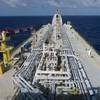Growing the Port Four Cranes at a Time
Spectacular sights are a tradition in the of , and shipspotters were all abuzz in mid-August about the spectacle at . There, for the third time in six years, a construction — not easy to tell exactly what at first, but sporting Maersk colors — lay at anchor as preparations were completed for the last leg of its journey. Whatever it was, it was huge and looked ungainly, certainly not something to take under bridges — the Verrazano, and uh-oh, the — at too high a tide. From the sight of it, which was far from symmetrical, it might have appeared a precarious balancing act.
On left, four sets of level beams supported four massive white boxes far outboard of the side of the ship, each emblazoned with the Maersk star. Standing the equivalent of 20-stories tall on the main deck were great vertical pillars, eight of them. On the right, angled upwards a bit in their long reach over the water, four massive booms painted red, white, and blue and labeled APM Terminals, completed the odd shape of the mass. Give it some thought and you'd figure it out — of course, those are gantry cranes, four of them, bound for , welded to the deck of a specially modified ship.
The assembly had arrived from the old-fashioned way — around the tip of . This was APM's third and final shipment of new cranes, for a total of 10 in the past half-dozen years, with perhaps another four over the next couple of years, to expand their throughput. This final leg of the cranes' voyage, the last few miles from Gravesend to , was the delicate one. The Kill Van Kull is narrower than the .
The Zhen Hua 10 is the largest, and one of the newest conversions by its owners, Shanghai Zenhua Port Machinery, or ZPMC. "They're the only crane builders with their own fleet for delivery" says George Dzurina, APM Terminals' General Manager, East and Gulf Coasts Crane Engineering and Management (known affectionately as "The G-Man"). "Altogether, they have twenty-six ships currently operating as needed, and two more under construction. They save an estimated $1 million off the cost of the cranes, delivered."
Of course, there must be a balance, economically speaking — how many cranes must you deliver to justify the cost of a ship, or a fleet of ships? ZPMC has delivered well over a thousand quayside container cranes worldwide, and over 1650 rubber tired gantry cranes. The Zhen Hua 10 can accommodate up to six cranes. "Most other crane builders," says Mr. Dzurina, "deliver around eight to fifteen cranes a year, and some send them disassembled."
APM Terminals has expanded its presence at Port Liz, with berthing space totaling just over a mile altogether. This latest group of cranes has super-post-Panamax in mind, consistent with the Port Authority's plans to attract the largest vessels afloat. "Most cranes can work ships that are seventeen stacks of containers wide. These can work twenty-two wide."
The expansion serves two purposes, as Mr. Dzurina describes it. The new cranes increase throughput — "APM did about 727,000 lifts in 2007, while projected for 2009 are 812,000" — and they also accelerate the loading and unloading process, shaving possibly days off a ship's stay quayside. "The more cranes we put on it, the faster we can have the ship depart."
Spectacles and Celebrations
The previous two deliveries of cranes to APM in — three cranes apiece on the Zhen Hua 4 and Zhen Hua 5 — went relatively unnoted, except by mariners and that population ashore that finds the harbor spectacular. But Zhen Hua 10 and her August delivery got more of a royal treatment. Perhaps to symbolize the completion of the long-range upgrade — ten new gantry cranes make a pretty big investment — one fireboats from Jersey City, one from Newark, and FDNY's own Fire Fighter met the procession as the massive structure negotiated everybody's favorite white-knuckle turn, the one off Bergen Point, going under the Bayonne and steering into Newark Bay.
With one exception, the Zhen Hua crane ships started life as bulk carriers — solid or liquid — the exception being one ex-containership. The 800-foot Zhen Hua 10 was reportedly built as an oil tanker in , 1981. Decks are cleared of all equipment, forming in effect a motorized barge to carry payloads of thousands of tons thousands of miles across the oceans. The decks are heavily reinforced to support the weight, and although the asymmetrical design of the whole looks precarious, the positions of the cranes and the angles of their booms maximize stability.
Clearing 's gateway bridges takes some effort, such as removing the gantry trucks — "saved us about ten feet," says Mr. Dzurina — but some ports don't have such obstacles to consider. "The Zen Hua 10 delivered six fully erected cranes to our terminal roughly two years ago. Those cranes were around 240 feet tall."
Welding the cranes to the deck, transforming vast individual assemblies plus ship into a single effective unit, would seem the only satisfactory way of moving such a mass across oceans. Mr. Dzurina says they were expected to be at sea about 65 days this time, crossing half the planet at nine to ten knots. "They can withstand seas that cause the ship to slant up to 20 degrees," Mr. Dzurina tells us, but of course the ocean sometimes slants things more. It would be typical for a Zhen Hua crane ship to wait-out weather in port, or steer well around it.
The efficacy of so doing was illustrated early this year, when a fierce storm off broke Zhen Hua 10 loose, whereupon with a load of five cranes she drifted toward the coast. According to reports, she beached and her propeller dug in, and there were concerns about capsizing. The first attempts to free her were foiled. Smit takes the credit for deballasting the ship and wresting her free, averting, in their words, "a nightmare." (See related story on page 38).
Long story short, the Zhen Hua 10 didn't capsize, didn't spill her load into the ocean (or on someone's beachfront home), didn't smash-down bridges or terminals or other waterfront structures, didn't become a nightmare, got herself together, and went on her way. Maybe there's something to this idea of welding cranes to the deck. Seven months later, Zhen Hua 10 was back in with another delivery.
Classics, Old and New
Shortly before 1300 hours on Sunday, August 17, Zhen Hua 10 fired-up for its cautious passage from Gravesend to . With VIPs watching from the Barbara Miller, four of Moran's best-looking tugs got into their final position. The James Turecamo, built as a canaler by Matton in 1969, is widely considered among the best-looking tugs of her type. The Miriam Moran, built ten years later, is a classic by any definition, a handsome reflection of what shipdocking tugs of her generation should look like. The Laura K. Moran, a Washburn and Doughty 92, represents the new classic in Z-drive tugs — and one of the last builds by the East Boothbay yard before its catastrophic fire in July. The Laura joined the fleet at the beginning of the year.
The James Turecamo headed-off on other business as the Joan Turecamo took position near Zhen Hua 10's starboard bow, the Miriam took the portside, and the Laura brought-up the rear. The sight of the flotilla seemed just a bit incongruous, for things as large as this are seldom in motion. Something the size of four twenty-story skyscrapers, made-up of more steel than many bridges, is something the eye expects to find rooted in place. Over the next couple of weeks, the cranes would be eased off the ship and set on their bases. And then they would go to work.
By increasing and accelerating throughput at the vast container port, the cranes would soon pursue their role in the harbor's growth. For more containers mean more ships, more tugs to assist, more lighters and barges to bring supplies. When the Zhen Hua 10 headed back to sea last month, she was departing a port which during her stay had grown considerably bigger.
SMIT Salvage performed strongly last year, with increased activity levels. This was followed by an encouraging first half for 2008.
Activities during the first quarter included a series of refloatings of vessels grounded in hostile weather. February saw SMIT Salvage achieve a first, with the refloating of three casualties in 24 hours. This set a new record for the company.
The first of the three casualties was the Zhen Hua 10, laden with five large ship-to-shore cranes when she grounded off . The former tanker, under Shanghai-based ownership, was in the last hours of a long voyage from when she was caught in a storm. Strong winds pushed the heavy cargo vessel onto a sandbank off the Maasvlakte on February 2. The 86,983 DWT vessel, only recently converted to the heavy lift role, grounded stern first, then rotated until parallel to the shoreline.
Refloating Zhen Hua 10
A helicopter succeeded in winching down the Salvage Master onto Zhen Hua 10's main deck, despite BF 10 conditions. He began to make his first assessment of the situation. The heavily laden vessel was rolling violently and bouncing on the seabed. The first priority was to ballast down and reduce the casualty's potentially damaging excessive movement in the storm. An additional 6,000 tons of ballast achieved the desired result.
This bought time, allowing the Salvage Master and his team to make a more detailed inspection of the casualty. The results were encouraging and preparations continued for a prompt refloating. Meanwhile, three harbour tugs had arrived on scene (including two SMIT tugs). They connected up to Zhen Hua 10. The large salvage tug Janus, with a hefty 220 tons bollard pull, also arrived on location. She increased the total bollard pull available to 350 tons.
Everything was well prepared and ready for the high water opportunity in the early hours of the morning of February 5. The vessel floated free at 01.07 hrs local and an inspection confirmed that there were no leakages. Zhen Hua 10 was safely at her berth in Europort by 08.00 hrs, well ahead of yet more bad weather.
On February 5 SMIT Salvage, achieved the record when other salvage teams refloated the bulk carrier Sagarkiran, from a reef near Jeddah, and the 8,000 TEU container vessel CMA CGM Don Carlos, which had grounded in the . Other first quarter operations included the refloating of the 45,000 DWT tanker Ficus at , following a grounding. The incident occurred on February 26, with the tanker laden with a cargo of jet fuel and other white oils. The casualty was freed by the tug Smit Oneida, together with local tugs.
(Reprinted from the September 2008 edition of MarineNews)














